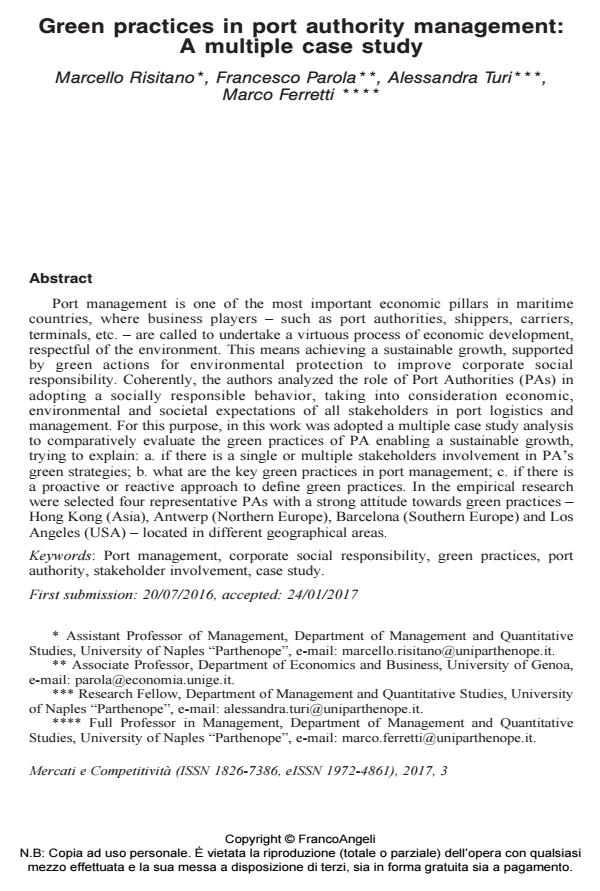Green practices in port authority management: A multiple case study
Journal title MERCATI & COMPETITIVITÀ
Author/s Marcello Risitano, Francesco Parola, Alessandra Turi, Marco Ferretti
Publishing Year 2017 Issue 2017/3
Language English Pages 19 P. 127-145 File size 118 KB
DOI 10.3280/MC2017-003008
DOI is like a bar code for intellectual property: to have more infomation
click here
Below, you can see the article first page
If you want to buy this article in PDF format, you can do it, following the instructions to buy download credits

FrancoAngeli is member of Publishers International Linking Association, Inc (PILA), a not-for-profit association which run the CrossRef service enabling links to and from online scholarly content.
Port management is one of the most important economic pillars in maritime countries, where business players - such as port authorities, shippers, carriers, terminals, etc. - are called to undertake a virtuous process of economic development, respectful of the environment. This means achieving a sustainable growth, supported by green actions for environmental protection to improve corporate social responsibility. Coherently, the authors analyzed the role of Port Authorities (PAs) in adopting a socially responsible behavior, taking into consideration economic, environmental and societal expectations of all stakeholders in port logistics and management. For this purpose, in this work was adopted a multiple case study analysis to comparatively evaluate the green practices of PA enabling a sustainable growth, trying to explain: a. if there is a single or multiple stakeholders involvement in PA’s green strategies; b. what are the key green practices in port management; c. if there is a proactive or reactive approach to define green practices. In the empirical research were selected four representative PAs with a strong attitude towards green practices - Hong Kong (Asia), Antwerp (Northern Europe), Barcelona (Southern Europe) and Los Angeles (USA) - located in different geographical areas.
Keywords: Port management, corporate social responsibility, green practices, port authority, stakeholder involvement, case study.
- Green Practices for Reducing Emissions in Port Services: Evidence from a Pilot Study Marco Ferretti, Giuseppe La Ragione, Luca Porcaro, Marcello Risitano, Alessandra Turi, in Sustainability /2025 pp.5316
DOI: 10.3390/su17125316 - Evaluating the economic and environmental efficiency of ports: Evidence from Italy Rosalia Castellano, Marco Ferretti, Gaetano Musella, Marcello Risitano, in Journal of Cleaner Production 122560/2020 pp.122560
DOI: 10.1016/j.jclepro.2020.122560
Marcello Risitano, Francesco Parola, Alessandra Turi, Marco Ferretti, Green practices in port authority management: A multiple case study in "MERCATI & COMPETITIVITÀ" 3/2017, pp 127-145, DOI: 10.3280/MC2017-003008